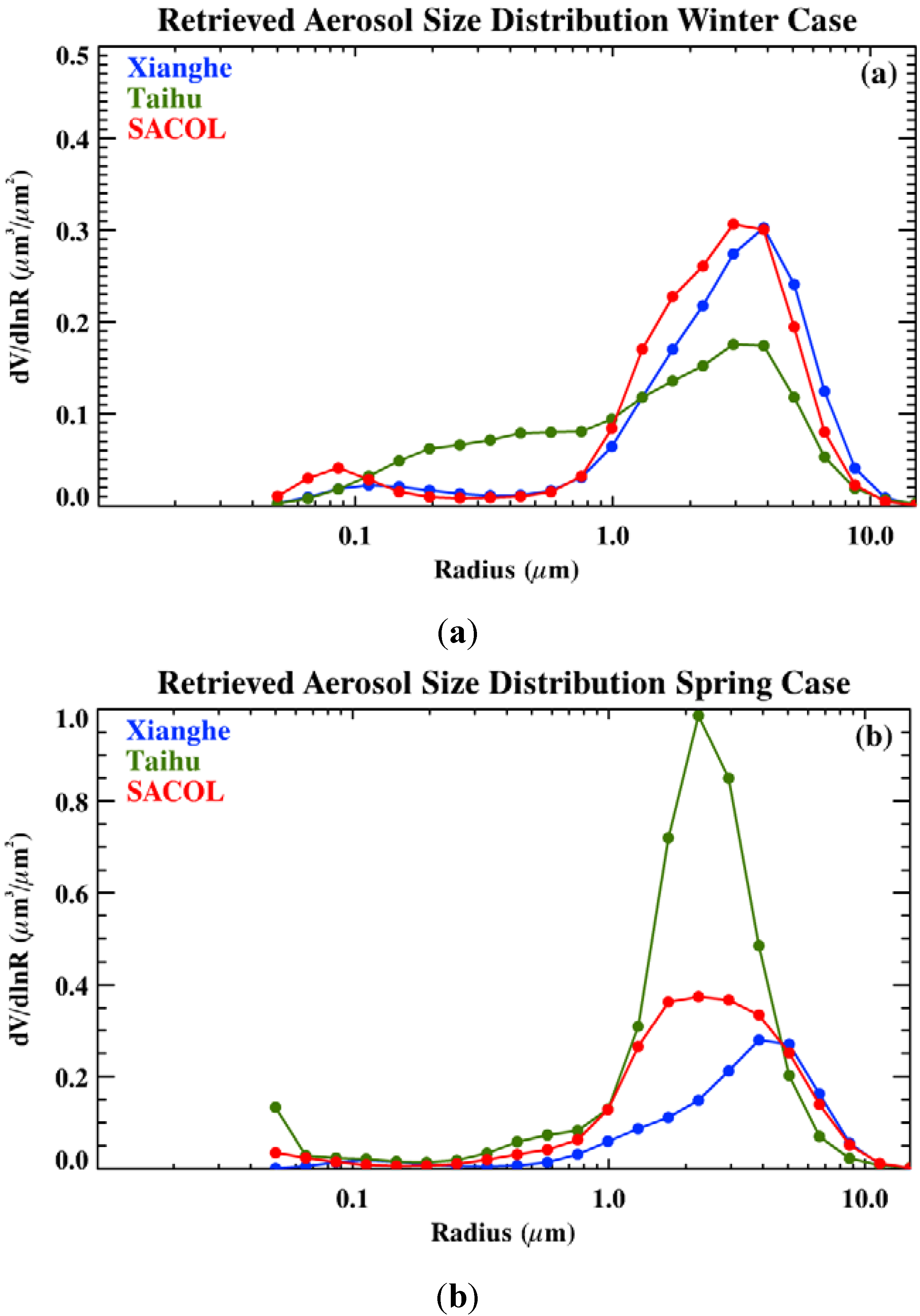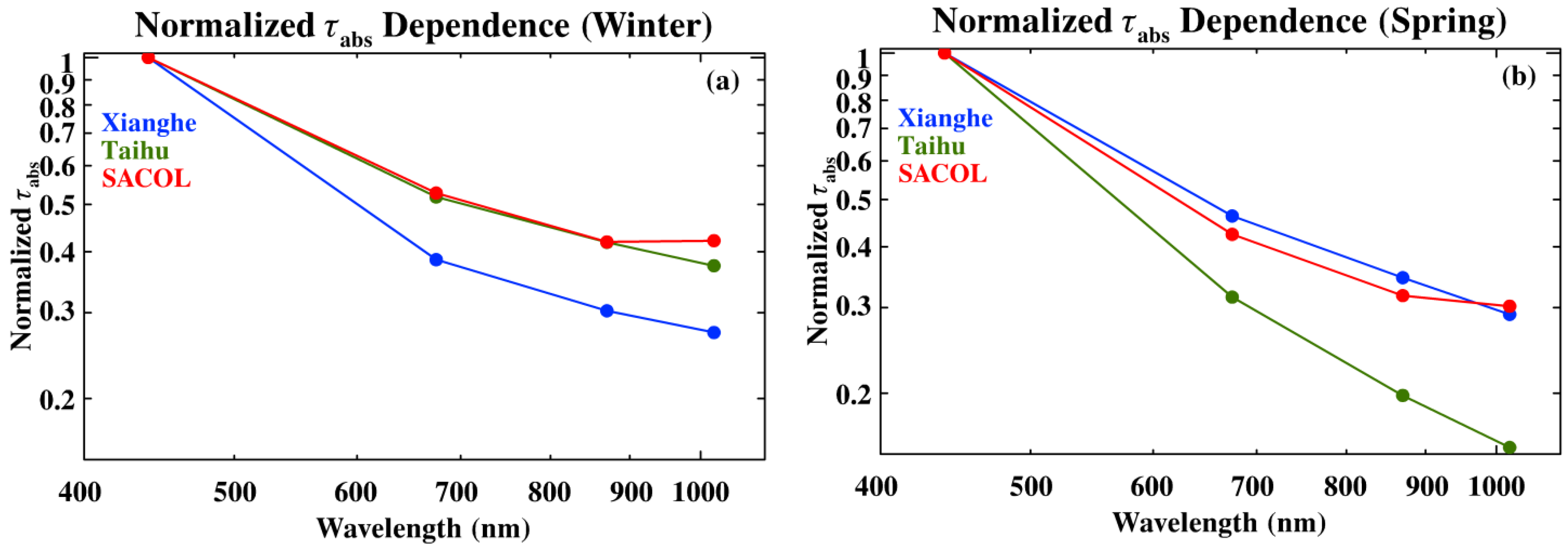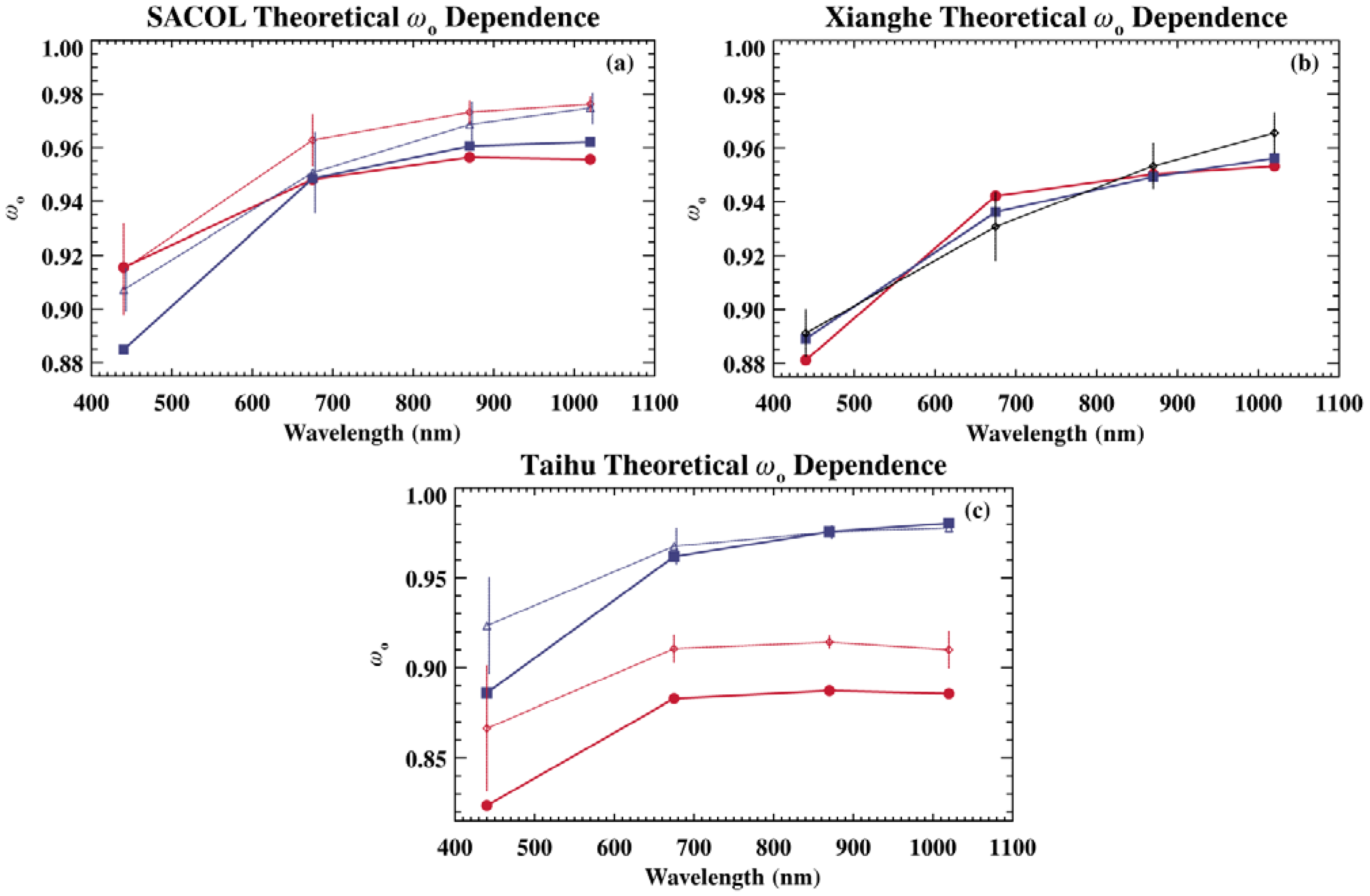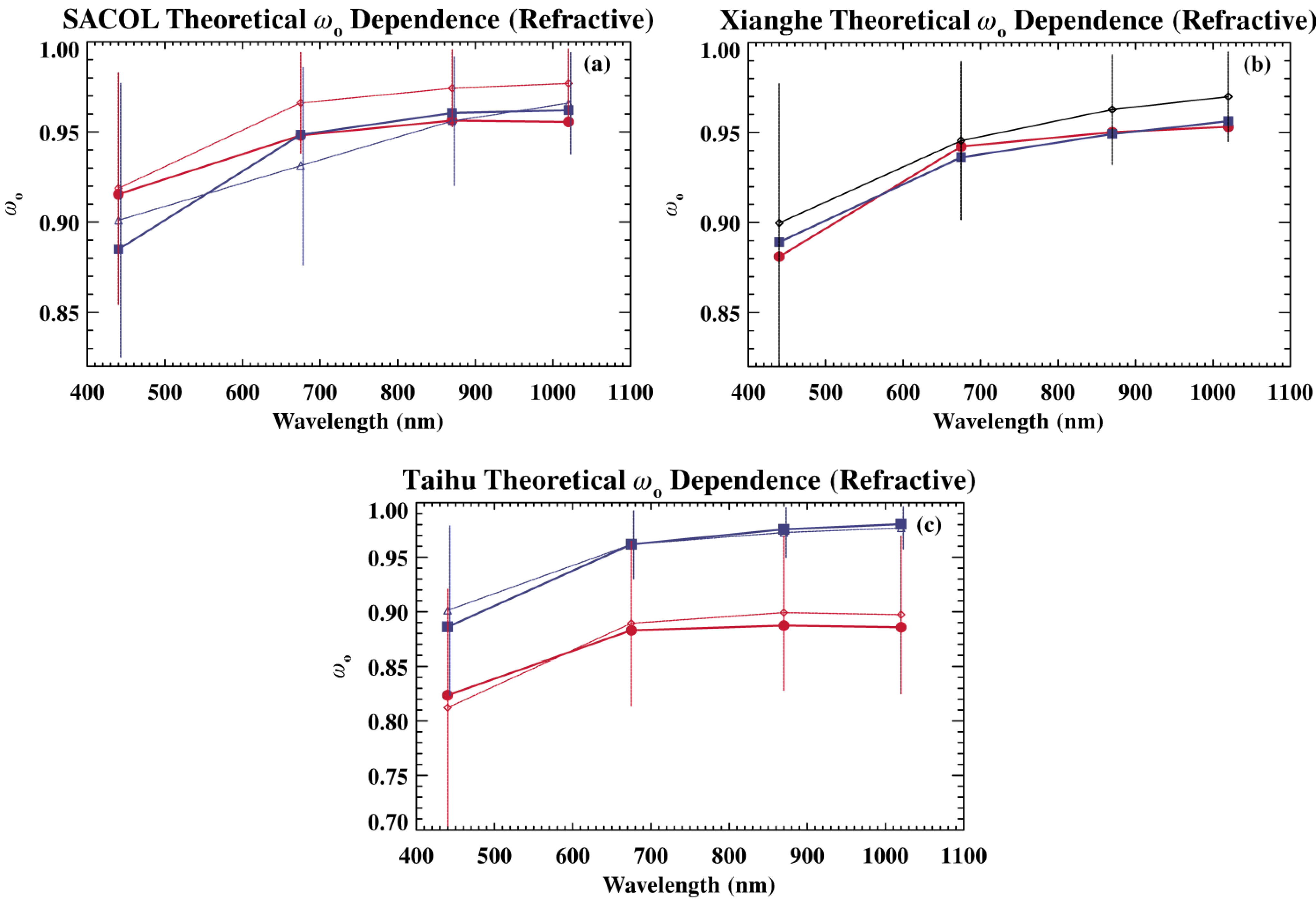A Comparison of the Mineral Dust Absorptive Properties between Two Asian Dust Events
Abstract
:1. Introduction
2. Data and Methodology
2.1. AERONET

2.2. Theoretical Mineral Dust Model
2.2.1. Comparison Study of ωo(λ) Involving the Aerosol Effective Radius and Complex Index of Refraction

3. Results and Discussions
3.1. Synoptic Pattern of the Two Dust Events
3.2. Mineral Dust Properties Inferred from the Particle Volume Size Distribution, τ, τabs, α440–870, and αabs440–870 Parameters



| AERONET Site | τ440 | α440–870 | αabs440–870 | mr | mi | reff |
|---|---|---|---|---|---|---|
| SACOL (winter) | 0.6 | 0.29 | 1.3 | 1.46 | 0.003 | 0.77 |
| SACOL (spring) | 0.8 | 0.11 | 1.7 | 1.57 | 0.004 | 0.97 |
| Xianghe (winter) | 0.6 | 0.48 | 1.8 | 1.60 | 0.005 | 1.07 |
| Xianghe (spring) | 0.5 | 0.42 | 1.6 | 1.60 | 0.004 | 1.25 |
| Taihu (winter) | 1.3 | 0.62 | 1.3 | 1.53 | 0.022 | 0.59 |
| Taihu (spring) | 1.4 | 0.15 | 2.5 | 1.53 | 0.004 | 0.80 |
3.3. Comparisons of ωo(λ) between Theoretical Calculations and AERONET Retrievals


| Aspect Ratio | mr | mi | reff (μm) | |
|---|---|---|---|---|
| SACOL (Winter Case) Fixed refractive index | 1.5:1.8 | 1.50 | 0.005 | 0.7 |
| 1.50 | 0.005 | 0.8 | ||
| 1.50 | 0.005 | 0.9 | ||
| 1.50 | 0.005 | 1.0 | ||
| SACOL (Spring Case) Fixed refractive index | 1.5:1.8 | 1.60 | 0.005 | 0.7 |
| 1.60 | 0.005 | 0.8 | ||
| 1.60 | 0.005 | 0.9 | ||
| 1.60 | 0.005 | 1.0 | ||
| SACOL (Winter Case) Fixed effective radius | 1.5:1.8 | 1.40 | 0.001 | 0.8 |
| 1.40 | 0.005 | 0.8 | ||
| 1.40 | 0.010 | 0.8 | ||
| 1.50 | 0.001 | 0.8 | ||
| 1.50 | 0.005 | 0.8 | ||
| 1.50 | 0.010 | 0.8 | ||
| 1.60 | 0.001 | 0.8 | ||
| 1.60 | 0.005 | 0.8 | ||
| 1.60 | 0.010 | 0.8 | ||
| SACOL (Spring Case) Fixed effective radius | 1.5:1.8 | 1.40 | 0.001 | 1.0 |
| 1.40 | 0.005 | 1.0 | ||
| 1.40 | 0.010 | 1.0 | ||
| 1.50 | 0.001 | 1.0 | ||
| 1.50 | 0.005 | 1.0 | ||
| 1.50 | 0.010 | 1.0 | ||
| 1.60 | 0.001 | 1.0 | ||
| 1.60 | 0.005 | 1.0 | ||
| 1.60 | 0.010 | 1.0 | ||
| Xianghe (Both Cases) Fixed refractive index | 1.8:2.1 | 1.60 | 0.005 | 1.0 |
| 1.60 | 0.005 | 1.1 | ||
| 1.60 | 0.005 | 1.2 | ||
| 1.60 | 0.005 | 1.3 | ||
| Xianghe (Both Cases) Fixed effective radius | 1.8:2.1 | 1.60 | 0.001 | 1.0 |
| 1.60 | 0.005 | 1.0 | ||
| 1.60 | 0.010 | 1.0 | ||
| Taihu (Winter Case) Fixed refractive index | 1.5:1.8 | 1.50 | 0.020 | 0.5 |
| 1.50 | 0.020 | 0.6 | ||
| 1.50 | 0.020 | 0.7 | ||
| 1.50 | 0.020 | 0.8 | ||
| 1.50 | 0.020 | 0.9 | ||
| Taihu (Spring Case) Fixed effective radius | 1.2:1.5 | 1.50 | 0.005 | 0.5 |
| 1.50 | 0.005 | 0.6 | ||
| 1.50 | 0.005 | 0.7 | ||
| 1.50 | 0.005 | 0.8 | ||
| 1.50 | 0.005 | 0.9 | ||
| Taihu (Winter Case) | 1.5:1.8 | 1.50 | 0.010 | 0.6 |
| 1.50 | 0.020 | 0.6 | ||
| 1.50 | 0.050 | 0.6 | ||
| Taihu (Spring Case) | 1.2:1.5 | 1.50 | 0.001 | 0.8 |
| 1.50 | 0.005 | 0.8 | ||
| 1.50 | 0.010 | 0.8 |
3.4. Aerosol Radiative Effect
| The clear-sky values were taken just before and after the dust event where τ440 < 0.3 and the ARE values for both clear-sky and dust events are calculated against the modeled fluxes without aerosol using Equation (2). Note that the Taihu site has the highest mean clear-sky ARE due to persistent haze from numerous nearby urban and industrial influences (i.e., very few “clear day” instances). | |||
| AERONET Site | BOA ARE Values (W·m−2) | ||
| Clear Sky (before) | Dust Event | Clear Sky (after) | |
| SACOL (winter) | −52.9 | −101.1 | −60.6 |
| SACOL (spring) | −48.5 | −136.7 | −52.5 |
| Xianghe (winter) | −64.2 | −106.4 | −39.8 |
| Xianghe (spring) | −40.7 | −83.0 | −42.1 |
| Taihu (winter) | −45.5 | −177.3 | −60.0 |
| Taihu (spring) | −66.9 | −155.3 | −40.8 |
| AERONET Site | TOA ARE Values (W·m−2) | ||
| Clear Sky (before) | Dust Event | Clear Sky (after) | |
| SACOL (winter) | −17.0 | −40.9 | −13.1 |
| SACOL (spring) | −4.5 | −40.9 | −8.5 |
| Xianghe (winter) | −15.3 | −46.0 | −8.6 |
| Xianghe (spring) | −17.1 | −29.7 | −9.1 |
| Taihu (winter) | −19.0 | −21.0 | −17.2 |
| Taihu (spring) | −27.3 | −60.4 | −26.5 |
4. Conclusions
Acknowledgements
References
- Li, Z.; Chen, H.; Cribb, M.; Dickerson, R.; Holben, B.; Li, C.; Lu, D.; Luo, Y.; Maring, H.; Shi, G.; Tsay, S.-C.; Wang, P.; Wang, Y.; Xia, X.; Zheng, Y.; Yuan, T.; Zhao, F. Aerosol optical properties and its radiative effects in northern China. J. Geophys. Res. 2007, 112. [Google Scholar] [CrossRef]
- Li, Z.; Chen, H.; Cribb, M.; Dickerson, R.; Holben, B.; Li, C.; Lu, D.; Luo, Y.; Maring, H.; Shi, G. Preface to special section on East Asian studies of tropospheric aerosols: An international regional experiment (EAST-AIRE). J. Geophys. Res. 2007, 112. [Google Scholar] [CrossRef]
- Tsunematsu, N.; Kai, K.; Matsumoto, T. The influence of synoptic-scale air flow and local circulation on the dust layer height in the north of the Taklimakan Desert. Water Air Soil Pollut. Focus 2005, 5, 175–193. [Google Scholar]
- Logan, T.; Xi, B.; Dong, X.; Obrecht, R.; Li, Z.; Cribb, M. A study of Asian dust plumes using satellite, surface, and aircraft measurements during the INTEX-B field experiment. J. Geophys. Res. 2010, 115. [Google Scholar] [CrossRef]
- Uematsu, M.; Duce, R.A.; Prospero, J.M.; Chen, L.; Merrill, J.T.; McDonald, R.L. Transport of mineral aerosol from Asia over the North Pacific Ocean. J. Geophys. Res. 1983, 88, 5343–5352. [Google Scholar]
- Jordan, C.E.; Dibb, J.E.; Anderson, B.E.; Fuelberg, H.E. Uptake of nitrate and sulfate on dust aerosols during TRACE-P. J. Geophys. Res. 2003, 108. [Google Scholar] [CrossRef]
- Ling, X.-L.; Guo, W.-D.; Zhao, Q.-F.; Zhang, B.D. A case study of a typical dust storm event over the Loess Plateau of Northwest China. Atmos. Oceanic Sci. Lett. 2011, 4, 344–348. [Google Scholar]
- Sun, Y.; Zhuang, G.; Wang, Y.; Zhao, X.; Li, J.; Wang, Z.; An, Z. Chemical composition of dust storms in Beijing and implications for the mixing of mineral aerosol with pollution aerosol on the pathway. J. Geophys. Res. 2005, 110. [Google Scholar] [CrossRef]
- Yao, X.; Chan, C.K.; Fang, M.; Cadle, S.; Chan, T.; Mulawa, P.; He, K.; Boming, Y. The water-soluble ionic composition of PM2.5 in Shanghai and Beijing, China. Atmos. Environ. 2002, 36, 4223–4234. [Google Scholar] [CrossRef]
- Logan, T.; Xi, B.; Dong, X.; Li, Z.; Cribb, M. Classification and investigation of Asian aerosol properties. Atmos. Chem. Phys. Discuss. 2012, 12, 18,927–18,958. [Google Scholar]
- Rosenfeld, D.; Lohmann, U.; Raga, G.B.; O’Dowd, C.D.; Kulmala, M.; Fuzzi, S.; Reissell, A.; Andreae, M.O. Flood or drought: How do aerosols affect precipitation? Science 2008, 321. [Google Scholar] [CrossRef]
- Li, Z.; Niu, F.; Fan, J.; Liu, Y.; Rosenfeld, D.; Ding, Y. Long-term impacts of aerosols on the vertical development of clouds and precipitation. Nat. Geosci. 2011, 4, 888–894. [Google Scholar]
- Qiu, Y.; Dong, X.; Xi, B.; Wang, Z. Effects of clouds and aerosols on surface radiation budget inferred from DOE AMF at Shouxian, China. Atmos. Ocean. Sci. Lett. 2013, 6, 1–5. [Google Scholar]
- Ge, J.M.; Su, J.; Ackerman, T.P.; Fu, Q.; Huang, J.P.; Shi, J.S. Dust aerosol optical properties retrieval and radiative forcing over northwestern China during the China-U.S. joint field experiment. J. Geophys. Res. 2010, 115. [Google Scholar] [CrossRef]
- García, O.E.; Díaz, J.P.; Expósito, F.J.; Díaz, A.M.; Dubovik, O.; Derimian, Y.; Dubuisson, P.; Roger, J.-C. Shortwave radiative forcing and efficiency of key aerosol types using AERONET data. Atmos. Chem. Phys. 2012, 12, 5129–5145. [Google Scholar]
- Pope, C.A. Air pollution and health—Good news and bad. N. Engl. J. Med. 2004, 351, 1132–1134. [Google Scholar]
- Wang, X.; Huang, J.; Zhang, R.; Chen, B.; Bi, J. Surface measurements of aerosol properties over northwest China during ARM China 2008 deployment. J. Geophys. Res. 2010, 115. [Google Scholar] [CrossRef]
- Xin, J.; Wang, Y.; Li, Z.; Wang, P.; Hao, W.M.; Nordgren, B.L.; Wang, S.; Liu, G.; Wang, L.; Wen, T.; Sun, Y.; Hu, B. Aerosol optical depth (AOD) and Angstrom exponent of aerosols observed by the Chinese Sun Hazemeter Network from August 2004 to September 2005. J. Geophys. Res. 2007, 112. [Google Scholar] [CrossRef]
- Eck, T.F.; Holben, B.N.; Dubovik, O.; Smirnov, A.; Goloub, P.; Chen, H.B.; Chatenet, B.; Gomes, L.; Zhang, X.-Y.; Tsay, S.-C.; Ji, Q.; Giles, D.; Slutsker, I. Columnar aerosol optical properties at AERONET sites in central eastern Asia and aerosol transport to the tropical mid-Pacific. J. Geophys. Res. 2005, 110. [Google Scholar] [CrossRef]
- Yi, B.; Hsu, C.N.; Yang, P.; Tsay, S.-C. Radiative transfer simulation of dust-like aerosols: Uncertainties from particle shape and refractive index. J. Aer. Sci. 2011, 42, 631–644. [Google Scholar] [CrossRef]
- Wang, Y.; Xin, J.; Li, Z.; Wang, S.; Wang, P.; Hao, W.M.; Nordgren, B.L.; Chen, H.; Wang, L.; Sun, Y. Seasonal variations in aerosol optical properties over China. J. Geophys. Res. 2011, 116. [Google Scholar] [CrossRef]
- Meng, Z.; Yang, P.; Kattawar, G.W.; Bi, L.; Liou, K.N.; Laszlo, I. Single-scattering properties of tri-axial ellipsoidal mineral dust aerosols: A database for application to radiative transfer calculations. J. Aer. Sci. 2010, 41, 501–512. [Google Scholar] [CrossRef]
- Holben, B.N.; Eck, T.F.; Slutsker, I.; Tanré, D.; Buis, J.P.; Setzer, A.; Vermote, E.; Reagan, J.A.; Kaufman, Y.J.; Nakajima, T.; Lavenu, F.; Jankowiak, I.; Smirnov, A. AERONET—A federated instrument network and data archive for aerosol characterization. Rem. Sens. Environ. 1998, 66, 1–16. [Google Scholar] [CrossRef]
- Holben, B.N.; Eck, T.F.; Slutsker, I.; Smirnov, A.; Sinyuk, A.; Schafer, A.J.; Giles, D.; Dubovik, O. AERONET’s version 2.0 quality assurance criteria, remote sensing of atmosphere and clouds. Proc. SPIE. 2006, 6408. [Google Scholar] [CrossRef]
- Dubovik, O.; King, M. A flexible inversion algorithm for retrieval of aerosol optical properties from Sun and sky radiance measurements. J. Geophys. Res. 2000, 105, 20673–20696. [Google Scholar] [CrossRef]
- Dubovik, O.; Smirnov, A.; Holben, B.N.; Eck, T.F.; King, M.D.; Kaufman, Y.J.; Slutsker, I. Accuracy assessments of aerosol optical properties retrieved from Aerosol Robotic Network (AERONET) Sun and sky radiance measurements. J. Geophys. Res. 2000, 105, 9791–9806. [Google Scholar]
- Ackerman, P.; Toon, O.B. Absorption of visible radiation in atmosphere containing mixtures of absorbing and nonabsorbing particles. Appl. Opt. 1981, 20, 3661–3668. [Google Scholar] [CrossRef]
- Dubovik, O.; Sinyuk, A.; Lapyonok, T.; Holben, B.N.; Mishchenko, M.; Yang, P.; Eck, T.F.; Volten, H.; Munoz, O.; Veihelmann, B.; et al. Application of spheroid models to account for aerosol particle nonsphericity in remote sensing of desert dust. J. Geophys. Res. 2006, 111. [Google Scholar] [CrossRef]
- Sun, J.; Zhang, M.; Liu, T. Spatial and temporal characteristics of dust storms in China and its surrounding regions, 1960−1999: Relations to source area and climate. J. Geophys. Res. 2001, 106, 10325–10333. [Google Scholar]
- NOAA/ESRL Physical Sciences Division, Boulder Colorado. 2012. Available online: www.esrl.noaa.gov/psd/ (accessed on 8 October 2012).
- Kalnay, E.; Kanamitsu, M.; Kistler, R.; Collins, W.; Deaven, D.; Gandin, L.; Iredell, M.; Saha, S.; White, G.; Woollen, J.; et al. The NCEP/NCAR reanalysis 40-year project. Bull. Amer. Meteor. Soc. 1996, 77, 437–471. [Google Scholar] [CrossRef]
- Yang, M.; Howell, S.G.; Zhuang, J.; Huebert, B.J. Attribution of aerosol light absorption to black carbon, brown carbon, and dust in China—Interpretations of atmospheric measurements during EAST-AIRE. Atmos. Chem. Phys. 2009, 9, 2035–2050. [Google Scholar] [CrossRef]
- Bergstrom, R.W.; Pilewskie, P.; Russell, P.B.; Redemann, J.; Bond, T.C.; Quinn, P.K.; Sierau, B. Spectral absorption properties of atmospheric aerosols. Atmos. Chem. Phys. 2007, 7, 5937–5943. [Google Scholar] [CrossRef]
- Russell, P.B.; Bergstrom, R.W.; Shinozuka, Y.; Clarke, A.D.; DeCarlo, P.F.; Jimenez, J.L.; Livingston, J.M.; Redemann, J.; Dubovik, O.; Strawa, A. Absorption Angström Exponent in AERONET and related data as an indicator of aerosol composition. Atmos. Chem. Phys. 2010, 10, 1155–1169. [Google Scholar] [CrossRef]
- NASA World Wind. 2012. Available online: http://worldwind.arc.noaa.gov/features.html (accessed on 1 January 2012).
© 2013 by the authors; licensee MDPI, Basel, Switzerland. This article is an open access article distributed under the terms and conditions of the Creative Commons Attribution license (http://creativecommons.org/licenses/by/3.0/).
Share and Cite
Logan, T.; Xi, B.; Dong, X. A Comparison of the Mineral Dust Absorptive Properties between Two Asian Dust Events. Atmosphere 2013, 4, 1-16. https://doi.org/10.3390/atmos4010001
Logan T, Xi B, Dong X. A Comparison of the Mineral Dust Absorptive Properties between Two Asian Dust Events. Atmosphere. 2013; 4(1):1-16. https://doi.org/10.3390/atmos4010001
Chicago/Turabian StyleLogan, Timothy, Baike Xi, and Xiquan Dong. 2013. "A Comparison of the Mineral Dust Absorptive Properties between Two Asian Dust Events" Atmosphere 4, no. 1: 1-16. https://doi.org/10.3390/atmos4010001






